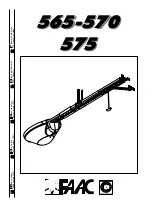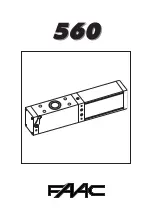
6 WG20 Instructions
2.3.3
CL20 Control Unit
2.3.4
PH1 Photocells
The CL20 unit actuates the gearmotors and provides for the control and
supply of the different components; it features an electronic board with
incorporated radio receiver; a housing [B] for the PR1 buffer battery
(optional), which is necessary for operation in case of power failure.
The CL20 control unit can actuate the gearmotors with two speeds:
"slow" and "fast".
The three P1, P2 and P3 buttons [C] and the corresponding LED's are
used to program the control unit.
To facilitate the electrical connections there are separate terminals for
each device [A], which are removable and colour-coded based on the
function performed. Next to each input terminal there is a LED that sig-
nals its status.
The connection to the power supply is very easy: just insert the plug in a
power outlet.
Table 2: List of small parts for CL20
Q.ty
4.2X32 self-tapping screw
4 pcs.
s 6 c nylon screw anchor
4 pcs.
Figure 5
A
B
C
The pair of PH1 wall-mounted photocells, once they are connected to
the control unit, enable the detection of obstacles found on the optical
axis between the transmitter (TX) and the receiver (RX).
Table 3: List of small parts for PH1
Q.ty
3.5X25 self-tapping screw
4 pcs.
4.2X32 self-tapping screw
4 pcs.
s 5 c nylon screw anchor
4 pcs.
2.3.5
KS1 Key-Operated Selector Switch
The KS1 key-operated two-position selector switch enables gate
control without using the radio transmitter. It is equipped with internal
light for locating in the dark.
There are two commands, which depend on the direction of rotation of
the key: "OPEN" and "STOP"; then the key, which is spring loaded,
returns to the centre position.
Figure 7
Table 4: List of small parts for KS1
Q.ty
HI LO 4X9.5 screw
2 pcs.
3.5X25 self-tapping screw
4 pcs.
s 5 c nylon screw anchor
4 pcs.
2.3.6
FL1 Flashing Light with Incorporated Aerial
Table 5: List of small parts for FL1
Q.ty
4.2X32 self-tapping screw
4 pcs.
s 6 c nylon screw anchor
4 pcs.
The flashing light is controlled by the CL20 control unit and signals
danger when the gate is moving. Inside the flashing light there is also
the aerial for the radio receiver.
Figure 8
2.3.7
TX4 Radio Transmitters
The radio transmitters are used for the remote control of the gate
opening and closing manoeuvres. They feature four buttons that can all
be used for the 4 types of command to a single automation unit, or to
control up to 4 different automation units.
The transmission of the command is confirmed by the LED [A]; an eyelet
[B] allows them to be hung on a keyring.
Figure 9
A
B
Figure 6







































